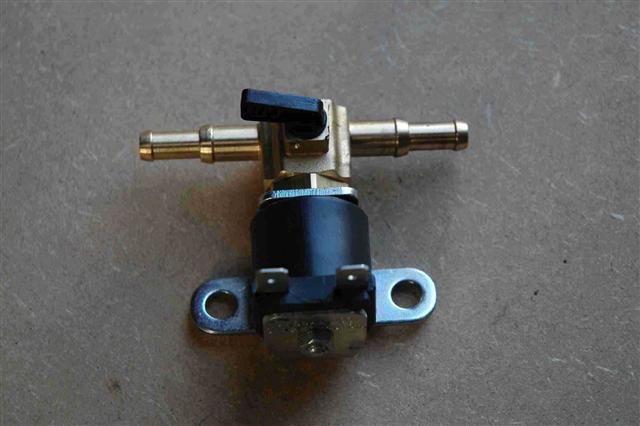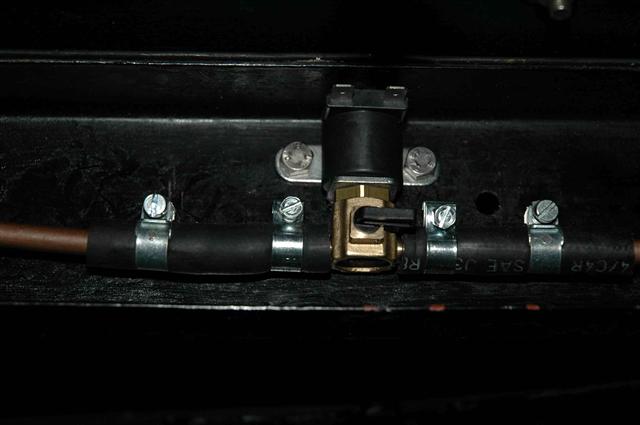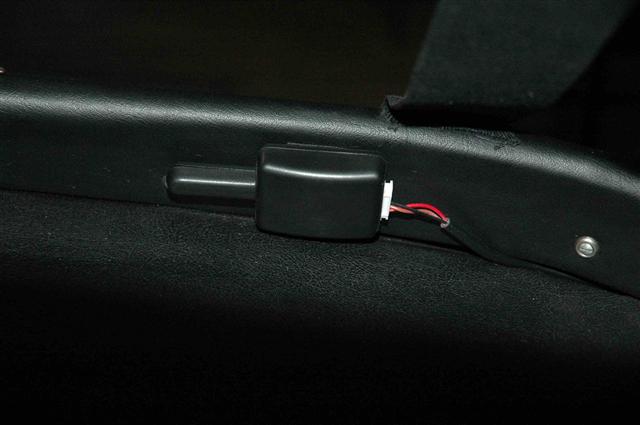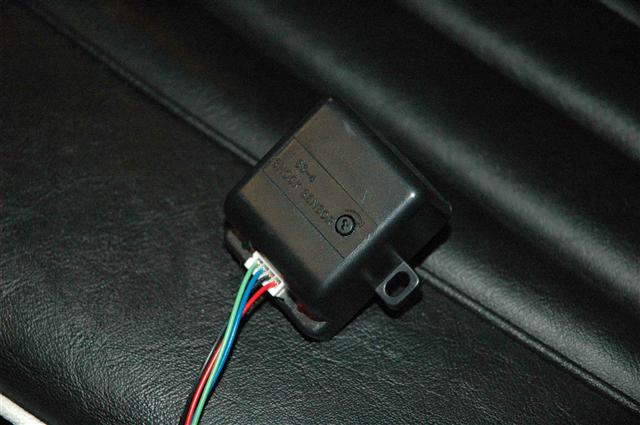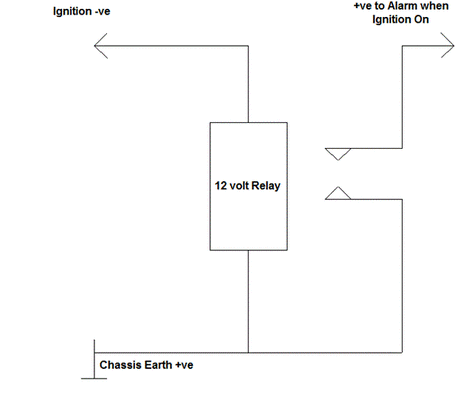Classic Car Security
This information was originally published as an article in TRaction the club magazine of the Triumph TR Register and although biassed towards the sidescreen Triumph TR's hopefully it will be useful to owners of other marques.
This information has been gathered from personal experience and is believed to be accurate but there is no guarantee that this is the case. Anyone using this information does so on the understanding that its use is completely at their own risk and that no legal liability of any kind will be accepted by the author for errors or ommisions or consequential damage to persons or possessions. Prospective users should make their own considered judgement or seek specialist advice as to the accuracy or otherwise of any statements made before using this information in any way. The procedures detailed below include modifications to both the fuel supply and the cars electrical system if you are not competent in either of these areas you are advised to seek expert help.
The recent increase in Classic car thefts prompted me to look at ways to protect my car from the villains. Modern cars are now without exception factory fitted with comprehensive security. Many of these use immobilisers that are embedded in the ECU (Electronic Control Unit or computer) that controls the engine etc. so are extremely difficult to bypass. This is probably one reason why Classics are now a target for criminals and as values increase there is a ready market for spares that are easily disposed of. Classic cars including side screen TR’s are basically very simple in construction both mechanically and electrically with most parts being very accessible, a modern stand-alone electronic immobiliser is thus not appropriate as its presence and function can easily be spotted and bypassed. So what are the options?
1. A mechanical device can be used to clamp a wheel, lock the steering, gearstick, handbrake or foot pedals
2. The steering wheel may be removed
3. The electrics can be disabled in some way
4. The fuel supply can be cut off
5. A paging device can be fitted
6. A tracking device can be fitted
If your car is targeted by a criminal it may be a random opportunist theft or could be stolen to order. If the latter they are likely to have done their homework and will have a much greater chance of success. All methods of prevention are really playing for time so the longer the methods take to overcome the best chance you have of maintaining ownership. A determined thief may actually be prepared to winch the car into a van or on to a trailer so unless they are caught in the act many of the above deterrents will prove useless.
Mechanical devices such as steering wheel locks take seconds for a criminal to overcome so offer little protection. Devices that lock the pedals to the floor are much better but are not widely advertised. Wheel clamps do seem fairly effective but are generally far too bulky to be carried in a TR. Removing the steering wheel is a good deterrent as even seasoned thieves are unlikely to carry appropriate replacements.
A battery cut off switch is very useful for isolating the supply but a thief intent on action will no doubt carry the plastic keys and can in any case easily short out the switch with a simple cable. Likewise a simple hidden switch in the ignition circuit is easily bypassed by wiring the ignition circuit direct to the battery.
Removing the rotor arm when leaving the vehicle will deter many opportunist thieves but a professional stealing a popular classic such as a Triumph TR or MG to order will no doubt carry a spare.
Cutting the fuel supply by solenoid valve and a hidden switch would not prevent the car being started so would not arise suspicion but would soon cause the engine to stall, a car stopping unexpectedly would no doubt unnerve most thieves into abandoning the car.
A paging device would seem to offer the big advantage that as soon as the vehicle is being interfered with the owner is warned by a bleeper.
Provided the owner is within about a half a mile of the car this should be successful. For cars stolen at car rallies etc. this seems a good solution. A tracking device mentioned above can also fulfil this function by warning the owner if the car is moved and also enable its position to be tracked, but as most trackers operate via the mobile telephone networks the car must be within the service area of the relevant mobile network to function.
A tracking device is claimed to be the most effective solution in that the stolen vehicle can be tracked continually, I am not convinced that a tracker
would still function if the car was winched into a steel bodied van. Trackers used to be very costly both to buy and for the subscription to the tracking service but over the past few years some inexpensive units have come to the market that may be linked to a normal mobile phone thus avoiding expensive subscriptions.
After considering the above I decided to adopt the following measures:
A) Install a battery isolation switch
B) Install a fuel cut off valve
C) Install a pager
This information has been gathered from personal experience and is believed to be accurate but there is no guarantee that this is the case. Anyone using this information does so on the understanding that its use is completely at their own risk and that no legal liability of any kind will be accepted by the author for errors or ommisions or consequential damage to persons or possessions. Prospective users should make their own considered judgement or seek specialist advice as to the accuracy or otherwise of any statements made before using this information in any way. The procedures detailed below include modifications to both the fuel supply and the cars electrical system if you are not competent in either of these areas you are advised to seek expert help.
The recent increase in Classic car thefts prompted me to look at ways to protect my car from the villains. Modern cars are now without exception factory fitted with comprehensive security. Many of these use immobilisers that are embedded in the ECU (Electronic Control Unit or computer) that controls the engine etc. so are extremely difficult to bypass. This is probably one reason why Classics are now a target for criminals and as values increase there is a ready market for spares that are easily disposed of. Classic cars including side screen TR’s are basically very simple in construction both mechanically and electrically with most parts being very accessible, a modern stand-alone electronic immobiliser is thus not appropriate as its presence and function can easily be spotted and bypassed. So what are the options?
1. A mechanical device can be used to clamp a wheel, lock the steering, gearstick, handbrake or foot pedals
2. The steering wheel may be removed
3. The electrics can be disabled in some way
4. The fuel supply can be cut off
5. A paging device can be fitted
6. A tracking device can be fitted
If your car is targeted by a criminal it may be a random opportunist theft or could be stolen to order. If the latter they are likely to have done their homework and will have a much greater chance of success. All methods of prevention are really playing for time so the longer the methods take to overcome the best chance you have of maintaining ownership. A determined thief may actually be prepared to winch the car into a van or on to a trailer so unless they are caught in the act many of the above deterrents will prove useless.
Mechanical devices such as steering wheel locks take seconds for a criminal to overcome so offer little protection. Devices that lock the pedals to the floor are much better but are not widely advertised. Wheel clamps do seem fairly effective but are generally far too bulky to be carried in a TR. Removing the steering wheel is a good deterrent as even seasoned thieves are unlikely to carry appropriate replacements.
A battery cut off switch is very useful for isolating the supply but a thief intent on action will no doubt carry the plastic keys and can in any case easily short out the switch with a simple cable. Likewise a simple hidden switch in the ignition circuit is easily bypassed by wiring the ignition circuit direct to the battery.
Removing the rotor arm when leaving the vehicle will deter many opportunist thieves but a professional stealing a popular classic such as a Triumph TR or MG to order will no doubt carry a spare.
Cutting the fuel supply by solenoid valve and a hidden switch would not prevent the car being started so would not arise suspicion but would soon cause the engine to stall, a car stopping unexpectedly would no doubt unnerve most thieves into abandoning the car.
A paging device would seem to offer the big advantage that as soon as the vehicle is being interfered with the owner is warned by a bleeper.
Provided the owner is within about a half a mile of the car this should be successful. For cars stolen at car rallies etc. this seems a good solution. A tracking device mentioned above can also fulfil this function by warning the owner if the car is moved and also enable its position to be tracked, but as most trackers operate via the mobile telephone networks the car must be within the service area of the relevant mobile network to function.
A tracking device is claimed to be the most effective solution in that the stolen vehicle can be tracked continually, I am not convinced that a tracker
would still function if the car was winched into a steel bodied van. Trackers used to be very costly both to buy and for the subscription to the tracking service but over the past few years some inexpensive units have come to the market that may be linked to a normal mobile phone thus avoiding expensive subscriptions.
After considering the above I decided to adopt the following measures:
A) Install a battery isolation switch
B) Install a fuel cut off valve
C) Install a pager
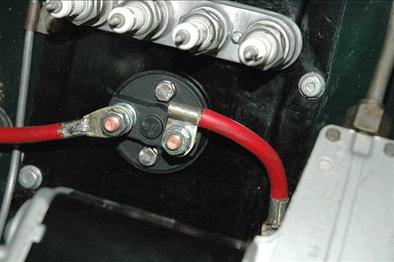
Battery Isolation Switch
More for peace of mind rather than a deterrent. Being able to fully isolate all electrics is a bonus to prevent potential electrical faults while parked. The nearside
blanking plate was a very convenient position for the switch and avoided hacking holes in the shiny bulkhead. It is close to the battery and the key is conveniently positioned under the glove box for isolation.
Fuel Shut Off Solenoid Valve
The fuel line from the tank to the carbure.ttors runs through the nearside chassis rails. The shut off valve can be partially hidden by mounting within the U-section and making a simple cover. Unless the car is placed on an inspection ramp it is unlikely to be noticed, even by looking under the vehicle. The solenoid valve is normally closed and requires 12 volts to open the valve and allow fuel to flow. This can be achieved by a small hidden switch fed from the ignition supply. The particular valve chosen has a manual bypass lever, so if for some reason the switch or the supply fails then the fuel supply may be manually turned on. As the lever is well hidden within the chassis rail, unless you are aware it would never be noticed and would require the car to be jacked up to reach the lever. During tests the car started normally but cuts out approximately after about 1minutes
running. When the valve is activated again the car starts almost immediately. I believe the closed valve causes a partial vacuum to prevent the petrol pump working as the fuel bowl is still full of petrol when the engine stops.
An important point, do not use ordinary jubilee clips to secure fuel pipe, the special fuel pipe clips provide a much more efficient and safer clamp.
The fuel line from the tank to the carbure.ttors runs through the nearside chassis rails. The shut off valve can be partially hidden by mounting within the U-section and making a simple cover. Unless the car is placed on an inspection ramp it is unlikely to be noticed, even by looking under the vehicle. The solenoid valve is normally closed and requires 12 volts to open the valve and allow fuel to flow. This can be achieved by a small hidden switch fed from the ignition supply. The particular valve chosen has a manual bypass lever, so if for some reason the switch or the supply fails then the fuel supply may be manually turned on. As the lever is well hidden within the chassis rail, unless you are aware it would never be noticed and would require the car to be jacked up to reach the lever. During tests the car started normally but cuts out approximately after about 1minutes
running. When the valve is activated again the car starts almost immediately. I believe the closed valve causes a partial vacuum to prevent the petrol pump working as the fuel bowl is still full of petrol when the engine stops.
An important point, do not use ordinary jubilee clips to secure fuel pipe, the special fuel pipe clips provide a much more efficient and safer clamp.
Fuel Cut Off Switch Cut off Switch Mounted on the Chassis A Fuel clip shown below a jubilee clip
A basic aluminium cover was fabricated from thin gauge material to cover the fuel cut off switch and secured to the underside of the chassis with two self tappers. If the solenoid valve failed it would be a simple matter to bend the cover and operate the manual tap. A sub-miniature toggle switch was fitted in a hidden but convenient place, but to ensure it was not inadvertently switched off I made up a simple metal guard.
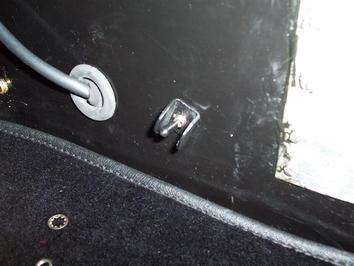
Miniature Toggle Switch with Simple Metal Guard
A Suppliers list can be found at the end of this article
Paging Systems
One economically priced alarm/immobiliser security system the Sniper X2 includes a pager as standard. The system comprises: A main control unit, shock sensor, siren, flashing Light Emitting diode (LED) and paging antenna all for around £70. The Sniper X2 is a comprehensive security system but only the pager and shock sensor were of interest for this application so most of the connections were not used, the redundant cables being trimmed for neatness. The Sniper X2 is designed for –ve (negative) earth systems but is easily adapted to the TR’s +ve (positive) earth. I decided to use two trigger sources for the pager:
1.The supplied shock sensor
2. Ignition
If a potential thief opens a door or sits on a seat the vibration is enough to cause the shock sensor to trigger the alarm on the pager. The sensitivity may be adjusted to avoid false triggering. Also if the ignition is switched on, the alarm is again triggered. The kit also includes a switch for boot or bonnet should this be thought necessary. A flashing LED is supplied to indicate alarm status. I mounted all the items using Velcro, the control box and shock sensor under the occasional rear seat and the antenna unit on the back rail under the tonneau cover.
Paging Systems
One economically priced alarm/immobiliser security system the Sniper X2 includes a pager as standard. The system comprises: A main control unit, shock sensor, siren, flashing Light Emitting diode (LED) and paging antenna all for around £70. The Sniper X2 is a comprehensive security system but only the pager and shock sensor were of interest for this application so most of the connections were not used, the redundant cables being trimmed for neatness. The Sniper X2 is designed for –ve (negative) earth systems but is easily adapted to the TR’s +ve (positive) earth. I decided to use two trigger sources for the pager:
1.The supplied shock sensor
2. Ignition
If a potential thief opens a door or sits on a seat the vibration is enough to cause the shock sensor to trigger the alarm on the pager. The sensitivity may be adjusted to avoid false triggering. Also if the ignition is switched on, the alarm is again triggered. The kit also includes a switch for boot or bonnet should this be thought necessary. A flashing LED is supplied to indicate alarm status. I mounted all the items using Velcro, the control box and shock sensor under the occasional rear seat and the antenna unit on the back rail under the tonneau cover.
The Sniper-2 Antenna Unit Mounted on the Tonneau rail The Sniper-X2 Shock Sensor
The Sniper-X2 system is designed for negative earth vehicles where the permanent and ignition supplies would be positive. As the TR3A is positive earth, the Snipers earth lead (black) is connected to the TR’s permanent live feed and the main positive supply lead (red) is connected
to the TR’s chassis earth. The unit requires a positive ignition feed to trigger the alarm so a relay is used to provide this from the TR’s negative
ignition feed. This Simple Circuit using a 12 Volt Relay Provides a Positive Ignition Trigger from a Positive Earth System:
to the TR’s chassis earth. The unit requires a positive ignition feed to trigger the alarm so a relay is used to provide this from the TR’s negative
ignition feed. This Simple Circuit using a 12 Volt Relay Provides a Positive Ignition Trigger from a Positive Earth System:
|
A Simple Circuit using a 12 Volt Relay Provides a Positive Ignition Trigger from a Positive Earth System
The pager is claimed to have a range up to ½ mile in open ground, but through buildings or difficult terrain this range would be reduced. During tests it certainly functioned well over 1/4 mile on open ground. Inexpensive Trackers Several inexpensive trackers are now available that communicate with a normal mobile phone through text messages (GSM). They use the global Positioning Satellites system (GBS) to transmit the cars position to the owners mobile. Since writing this article the market has changed in that many suppliers have developed there own user friendly software to enable easy tracking but this comes with the downside of a monthly subscription. 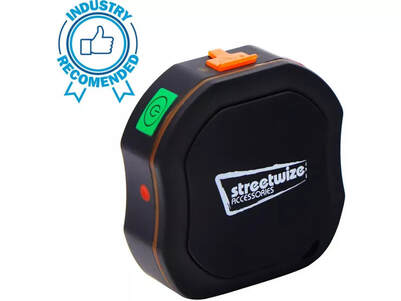
Subscription free trackers
These are still available and one available from Halfords is shown to the right by Streetwize To enable communication the unit requires a 2G Sim card, identical to the Sim Card in a mobile phone, which plugs into the side. If a "Pay as you Go" (PAYG) SIM Card is bought the running costs are very low as text messages only are being transmitted. Check with the Sim Card supplier that it is suitable for use in a tracker as some apparently are not. Be aware that the tracker will only operate on the network supported by the SIM card. Although most mobile networks have .now moved on from 2G to 3G, then 4g and even 5G apart from "3" network all are currently backward compatible to the 2G network. One advantage of this is that many country areas are still only on 2G so that the potential network coverage could be much wider. The Sim Card must be enabled with the relevant Network provider otherwise it will not function. As the tracker has no dialling facilities the network provider will do this on request if you explain that the Sim is for a tracker. The phone number on the Sim card is now dedicated to the tracker. Alternatively you could use a 2G Sim from a working phone. Operation The " Streetwize" instruction manual is available here: Manual 
Subscription based Tracker
The Rewire Security DB2 Self-Install GPS Car Tracker is a compact and self-contained GPS tracker ideal for tracking and locating personal cars. We have managed to squeeze a GPS/GNSS module for location tracking along with a GSM module, an accelerometer (for theft and crash detection). The DB2 does not require any external antennae to operate! After installing the DB2 tracking device on your car, your car will automatically start reporting it’s location and speed, along with many other useful parameters to our cloud-based GPS Tracking software, GPSLive. GPSLive can be accessed from Smartphones, Tablets, or other web-enabled devices anytime to view the real-time GPS data about your vehicles. There is no need to install any proprietary software or maps to your computer. The Rewire security DB2 self install vehicle tracker. is shown here. Summary
The Streetwize appears to be a cost effective way of tracking a vehicle as it avoids regular subscriptions albeit with some limitations. The pay as you go ( PAYG) 2G Sim card and top ups are the only real expense. If a more user friendly tracker is required then one of the subscription based systems may be a better option e.g. that offered by Rewire Security as an example. This has the big advantage of being very user friendly |
